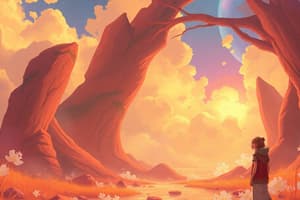Podcast
Questions and Answers
What must art not be viewed as, in order to fully grasp its complexity?
What must art not be viewed as, in order to fully grasp its complexity?
- A commercial item
- A decorative object
- A simple product (correct)
- A historical artifact
Which of the following factors does NOT influence the production of art in society?
Which of the following factors does NOT influence the production of art in society?
- Economic structures
- Political commitment
- Climate geography
- Artistic preference (correct)
What is the relationship between material conditions and art production?
What is the relationship between material conditions and art production?
- Art production is completely independent of material conditions.
- Material conditions limit creativity in art.
- Art is only possible if material conditions permit it. (correct)
- Material conditions enhance the aesthetic appeal of art.
How is the value of an art object described?
How is the value of an art object described?
Which of the following best describes the art world?
Which of the following best describes the art world?
What underpins the socio-political relationships in art production?
What underpins the socio-political relationships in art production?
Which of the following is NOT a factor affecting the standards of representation in cultures?
Which of the following is NOT a factor affecting the standards of representation in cultures?
The term 'material conditions' in the context of art relates to which of the following?
The term 'material conditions' in the context of art relates to which of the following?
What do contemporary art contexts indicate about the creation of art?
What do contemporary art contexts indicate about the creation of art?
Which of the following is NOT considered part of fine art?
Which of the following is NOT considered part of fine art?
How does the study of art relate to local context?
How does the study of art relate to local context?
What has contributed to the expansion of fine arts in the 20th century?
What has contributed to the expansion of fine arts in the 20th century?
Which factor is associated with the establishment of value in art contexts?
Which factor is associated with the establishment of value in art contexts?
What is a characteristic of fine art, according to contemporary norms?
What is a characteristic of fine art, according to contemporary norms?
Which of the following categories has emerged as part of fine arts in the 20th century?
Which of the following categories has emerged as part of fine arts in the 20th century?
What is an important aspect of questioning art contexts?
What is an important aspect of questioning art contexts?
What defines three-dimensional arts?
What defines three-dimensional arts?
Which of the following is NOT a form of dance mentioned?
Which of the following is NOT a form of dance mentioned?
What are the primary dimensions that two-dimensional art encompasses?
What are the primary dimensions that two-dimensional art encompasses?
Which of the following best describes the nature of theatre as an art form?
Which of the following best describes the nature of theatre as an art form?
What materials are commonly used in creating three-dimensional arts?
What materials are commonly used in creating three-dimensional arts?
What categorizes dance forms apart from their movement?
What categorizes dance forms apart from their movement?
What role does architecture serve in the context of visual arts?
What role does architecture serve in the context of visual arts?
What is the primary method of creating a film?
What is the primary method of creating a film?
What distinguishes creativity from mere novelty?
What distinguishes creativity from mere novelty?
Which component is NOT one of the fundamental components of contemporary art?
Which component is NOT one of the fundamental components of contemporary art?
What is the primary focus of interpretation in art?
What is the primary focus of interpretation in art?
What does the formal element 'composition' refer to in a work of art?
What does the formal element 'composition' refer to in a work of art?
How is art described in its relation to language?
How is art described in its relation to language?
What aspect does Political Economy examine in the context of art production?
What aspect does Political Economy examine in the context of art production?
What should one focus on to appreciate the form of art?
What should one focus on to appreciate the form of art?
Which of the following is an essential aspect of the language of art?
Which of the following is an essential aspect of the language of art?
What is the primary purpose of art history?
What is the primary purpose of art history?
Which of the following is NOT one of the aesthetic theories of art criticism?
Which of the following is NOT one of the aesthetic theories of art criticism?
What does the term 'provenance' refer to in historical inquiry into a work of art?
What does the term 'provenance' refer to in historical inquiry into a work of art?
Which aspect does 'iconography' focus on in the evaluation of art?
Which aspect does 'iconography' focus on in the evaluation of art?
What is the significance of 'authenticity' in art historical inquiry?
What is the significance of 'authenticity' in art historical inquiry?
What does the aesthetic theory of 'Imitationalism' assert about art?
What does the aesthetic theory of 'Imitationalism' assert about art?
Which element of a work of art is indicated by the term 'function' in historical inquiry?
Which element of a work of art is indicated by the term 'function' in historical inquiry?
In art analysis, what do the 'remarkable characteristics or qualities' of a work refer to?
In art analysis, what do the 'remarkable characteristics or qualities' of a work refer to?
Flashcards are hidden until you start studying
Study Notes
Defining Art
- Art is complex and should not be viewed as only a product, but also as the processes of its production within society, culture, and history.
- Cultural practice and shared meaning are key factors in defining art.
- Society's power structures and its material conditions influence the production of art.
- Material conditions encompass labor power, means of production (tools, technology, resources), and social and technical relations of production (property, power, control).
Regional Context
- The study of art should begin within one's regional context.
- This is where personal and group identities, and the idea of homeland are rooted.
- The region serves as a key identity marker.
Forms, Styles, and Practices in Contemporary Art
- The contemporary world is saturated with images and visual objects.
- Some forms are classified as fine art, while others are categorized as popular culture.
- Crafts are sometimes distinguished from art and are often seen as part of traditional practices.
Categories of Art
- Fine Art: Transcend average works, created by artists with unique sensibilities and academic training.
- Includes painting, sculpture, and architecture in the 19th century.
- Has expanded to include film, photography, installations, performance, video, and digital art.
- Visual Arts: Artworks created for visual perception.
- Music: Categorized as folk, indigenous, classical, popular, or independent.
- Two-Dimensional Art: Includes drawings, paintings, prints, and photographs.
- Three-Dimensional Art: Consists of objects with height, width, and depth, such as sculptures, jewelry, furniture, and monuments.
- Architecture: Includes religious, residential, industrial, and commercial structures.
- Dance: A form of art that uses purposely selected sequences of movement to convey aesthetic and symbolic value.
- Categories include ballet, folk, indigenous, street, modern, and popular styles.
- Theatre: A collaborative art form that uses live performers to present real or imagined events.
- Types include street theatre, school plays, ritual performances, sectoral productions, travelling troupes, and puppet shows.
- Film: A sequence of still photographs shot rapidly and projected to create the illusion of movement.
- Video Art: Records both image and sound, displayed on monitors.
- Photography: The primary means of forming knowledge and interpreting meanings about ourselves and the social world.
The Language of Art
- Art is akin to a language that communicates meanings beyond text and verbal expression.
- The language of art interprets reality rather than simply reflecting it.
- Components of the language of art include:
- The image: The visual representation of the artwork.
- Icons and Symbols: The visual elements conveying specific meanings.
- Environment: The context where the art is used or displayed.
- Cultural Traditions: Beliefs and values that inform the artwork.
- Intellectual Ideas: Writings and concepts that contribute to understanding the work.
Interpretation
- Interpretation seeks to establish meaningful connections between what we see and feel in an artwork.
- Multiple interpretations are possible for every artwork.
Political Economy of Art
- Political economy concerns itself with power and the distribution of economic resources in the context of art production.
Art Criticism
- Art criticism involves learning criteria for judgment and asking questions about the nature of art, creativity, and artistic merit.
- Key questions include:
- What is art?
- Are all people creative?
- Does every piece of art deserve praise?
- Can something be art in one culture but not in another?
- Three aesthetic theories of art criticism:
- Imitationalism: Art should imitate life and look realistic.
- Formalism: Focuses on the form and structure of the artwork.
- Emotionalism: Emphasizes the emotional impact of the artwork on the viewer.
Art History
- Art history establishes the timeline and sequence of events in the development of art.
- It includes a range of inquiries:
- Attribution: Investigating the artist, time, place, and reasons for creating the work.
- Authenticity: Verifying the attribution of the work through scholarly methods.
- Iconography: Analyzing the meanings of objects, symbols, and motifs.
- Provenance: Tracing the ownership history of the work.
- Function: Determining the original purpose of the artwork.
- Style: Identifying distinctive characteristics and qualities of the work.
Studying That Suits You
Use AI to generate personalized quizzes and flashcards to suit your learning preferences.





